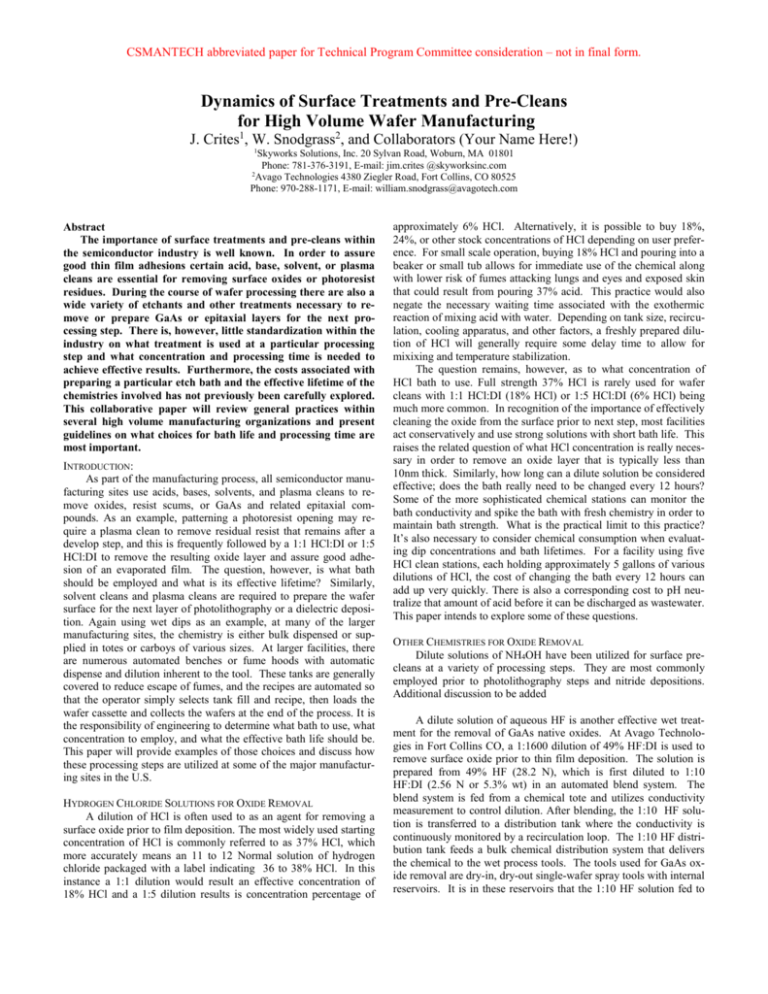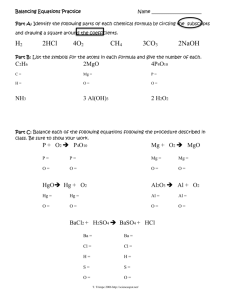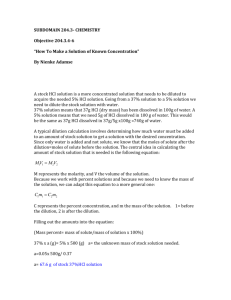84R-Dynamics of Surf..
advertisement

CSMANTECH abbreviated paper for Technical Program Committee consideration – not in final form. Dynamics of Surface Treatments and Pre-Cleans for High Volume Wafer Manufacturing J. Crites1, W. Snodgrass2, and Collaborators (Your Name Here!) 1 Skyworks Solutions, Inc. 20 Sylvan Road, Woburn, MA 01801 Phone: 781-376-3191, E-mail: jim.crites @skyworksinc.com 2 Avago Technologies 4380 Ziegler Road, Fort Collins, CO 80525 Phone: 970-288-1171, E-mail: william.snodgrass@avagotech.com Abstract The importance of surface treatments and pre-cleans within the semiconductor industry is well known. In order to assure good thin film adhesions certain acid, base, solvent, or plasma cleans are essential for removing surface oxides or photoresist residues. During the course of wafer processing there are also a wide variety of etchants and other treatments necessary to remove or prepare GaAs or epitaxial layers for the next processing step. There is, however, little standardization within the industry on what treatment is used at a particular processing step and what concentration and processing time is needed to achieve effective results. Furthermore, the costs associated with preparing a particular etch bath and the effective lifetime of the chemistries involved has not previously been carefully explored. This collaborative paper will review general practices within several high volume manufacturing organizations and present guidelines on what choices for bath life and processing time are most important. INTRODUCTION: As part of the manufacturing process, all semiconductor manufacturing sites use acids, bases, solvents, and plasma cleans to remove oxides, resist scums, or GaAs and related epitaxial compounds. As an example, patterning a photoresist opening may require a plasma clean to remove residual resist that remains after a develop step, and this is frequently followed by a 1:1 HCl:DI or 1:5 HCl:DI to remove the resulting oxide layer and assure good adhesion of an evaporated film. The question, however, is what bath should be employed and what is its effective lifetime? Similarly, solvent cleans and plasma cleans are required to prepare the wafer surface for the next layer of photolithography or a dielectric deposition. Again using wet dips as an example, at many of the larger manufacturing sites, the chemistry is either bulk dispensed or supplied in totes or carboys of various sizes. At larger facilities, there are numerous automated benches or fume hoods with automatic dispense and dilution inherent to the tool. These tanks are generally covered to reduce escape of fumes, and the recipes are automated so that the operator simply selects tank fill and recipe, then loads the wafer cassette and collects the wafers at the end of the process. It is the responsibility of engineering to determine what bath to use, what concentration to employ, and what the effective bath life should be. This paper will provide examples of those choices and discuss how these processing steps are utilized at some of the major manufacturing sites in the U.S. HYDROGEN CHLORIDE SOLUTIONS FOR OXIDE REMOVAL A dilution of HCl is often used to as an agent for removing a surface oxide prior to film deposition. The most widely used starting concentration of HCl is commonly referred to as 37% HCl, which more accurately means an 11 to 12 Normal solution of hydrogen chloride packaged with a label indicating 36 to 38% HCl. In this instance a 1:1 dilution would result an effective concentration of 18% HCl and a 1:5 dilution results is concentration percentage of approximately 6% HCl. Alternatively, it is possible to buy 18%, 24%, or other stock concentrations of HCl depending on user preference. For small scale operation, buying 18% HCl and pouring into a beaker or small tub allows for immediate use of the chemical along with lower risk of fumes attacking lungs and eyes and exposed skin that could result from pouring 37% acid. This practice would also negate the necessary waiting time associated with the exothermic reaction of mixing acid with water. Depending on tank size, recirculation, cooling apparatus, and other factors, a freshly prepared dilution of HCl will generally require some delay time to allow for mixixing and temperature stabilization. The question remains, however, as to what concentration of HCl bath to use. Full strength 37% HCl is rarely used for wafer cleans with 1:1 HCl:DI (18% HCl) or 1:5 HCl:DI (6% HCl) being much more common. In recognition of the importance of effectively cleaning the oxide from the surface prior to next step, most facilities act conservatively and use strong solutions with short bath life. This raises the related question of what HCl concentration is really necessary in order to remove an oxide layer that is typically less than 10nm thick. Similarly, how long can a dilute solution be considered effective; does the bath really need to be changed every 12 hours? Some of the more sophisticated chemical stations can monitor the bath conductivity and spike the bath with fresh chemistry in order to maintain bath strength. What is the practical limit to this practice? It’s also necessary to consider chemical consumption when evaluating dip concentrations and bath lifetimes. For a facility using five HCl clean stations, each holding approximately 5 gallons of various dilutions of HCl, the cost of changing the bath every 12 hours can add up very quickly. There is also a corresponding cost to pH neutralize that amount of acid before it can be discharged as wastewater. This paper intends to explore some of these questions. OTHER CHEMISTRIES FOR OXIDE REMOVAL Dilute solutions of NH4OH have been utilized for surface precleans at a variety of processing steps. They are most commonly employed prior to photolithography steps and nitride depositions. Additional discussion to be added A dilute solution of aqueous HF is another effective wet treatment for the removal of GaAs native oxides. At Avago Technologies in Fort Collins CO, a 1:1600 dilution of 49% HF:DI is used to remove surface oxide prior to thin film deposition. The solution is prepared from 49% HF (28.2 N), which is first diluted to 1:10 HF:DI (2.56 N or 5.3% wt) in an automated blend system. The blend system is fed from a chemical tote and utilizes conductivity measurement to control dilution. After blending, the 1:10 HF solution is transferred to a distribution tank where the conductivity is continuously monitored by a recirculation loop. The 1:10 HF distribution tank feeds a bulk chemical distribution system that delivers the chemical to the wet process tools. The tools used for GaAs oxide removal are dry-in, dry-out single-wafer spray tools with internal reservoirs. It is in these reservoirs that the 1:10 HF solution fed to CSMANTECH abbreviated paper for Technical Program Committee consideration – not in final form. the tool is further diluted to 1:1600 HF:DI (0.0176 N or 0.035% wt) by metering the volume of 1:10 HF and DI dispensed. A typical oxide removal sequence consumes approximately 125 mL of the 1:1600 solution for each wafer. At a cost of less than $20 per gallon for the 49% HF feedstock, the raw material cost of this oxide removal approach amounts to about 1/25th of 1 cent or about $0.01 for every 25 wafers processed. Oxide removal by 1:1600 HF:DI is typically preceded by some form of oxygen plasma descum, and followed by thin film deposition such as metal evaporation or PECVD dielectric deposition. A 1 hour time limit between oxide removal and the start of the subsequent deposition is imposed to minimize native oxide regrowth. TMAH is a strong base that is readily available in pre-diluted form in most wafer fabs, where it is used as photoresist developer. These diluted solutions of TMAH may also be used to remove surface oxide from GaAs. Oxide removal is necessary to ensure good adhesion of some photoresists to a GaAs surface, and since the diluted TMAH solutions are available on the same tools that perform the photoresist coating, it can be convenient to use them as the oxide removal chemistry of choice for this application. A typical developer solution is 2.4% TMAH (0.26 N). With a dispense volume of approximately 60 mL, the chemical cost of this process is about $0.05 per wafer—substantially more than dedicated oxide removal solutions but still an insignificant contributor to total wafer cost. CHARACTERIZATION OF OXIDE REMOVAL PROCESSES Spectroscopic ellipsometry and XPS are used to characterize oxide thickness and surface composition. These data are used to gauge the effectiveness of oxide removal processes and the rate of native oxide formation under different conditions. Data will be presented to demonstrate the effectiveness of the oxide removal processes described here and the evolution of native oxide formation in clean room air after oxide removal. SOLVENT CLEANS AND OTHER WET PROCESSING Other aspects of wafer clean are also critically important… ACRONYMS: TMAH: Tetramethylammonium hydroxide XPS: X-ray photoelectron spectroscopy







